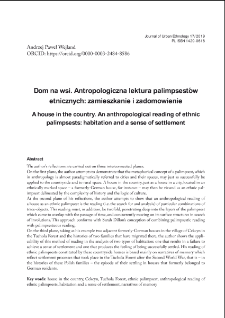
Obiekt
Tytuł: Dom na wsi. Antropologiczna lektura palimpsestów etnicznych: zamieszkanie i zadomowienie
Inny tytuł:
Journal of Urban Ethnology 17 (2019) ; A house in the country. An anthropological reading of ethnic palimpsests: habitation and a sense of settlement
Wydawca:
Instytut Archeologii i Etnologii PAN
Miejsce wydania:
Opis:
Typ obiektu:
Abstrakt:
The author’s reflections are carried out on three interconnected planes. On the first plane, the author attempts to demonstrate that the metaphorical concept of a palimpsest, which in anthropology is almost paradigmatically referred to cities and their spaces, may just as successfully be applied to the countryside and to rural space. A house in the country, just as a house in a city, located in an ethnically marked space – a formerly-German house, for instance – may then be viewed as an ethnic palimpsest delineated by the complexity of history and the logic of culture. At the second plane of his reflections, the author attempts to show that an anthropological reading of a house as an ethnic palimpsest is the reading (i.e. the search for and analysis) of particular combinations of trace-objects. This reading must, in addition, be twofold, penetrating deep into the layers of the palimpsest which came to overlap with the passage of time, and concurrently moving on its surface structures in search of involutions. This approach conforms with Sarah Dillon’s conception of combining palimpsestic reading with palimpsestuous reading. On the third plane, taking as his example two adjacent formerly-German houses in the village of Cekcyn in the Tuchola Forest and the histories of two families that have migrated there, the author shows the applicability of this method of reading in the analysis of two types of habitation: one that results in a failure to achieve a sense of settlement and one that produces the feeling of being successfully settled. His reading of ethnic palimpsests constituted by these countryside houses is based mainly on narratives of memory which reflect settlement processes that took place in the Tuchola Forest after the Second World War, that is – in the histories of these Polish families – the episode of their settling in houses that formerly belonged to German residents
Czasopismo/Seria/cykl:
Tom:
Strona pocz.:
Strona końc.:
Szczegółowy typ zasobu:
Format:
Identyfikator zasobu:
oai:rcin.org.pl:113606 ; 1429-0618
Źródło:
IAiE PAN, call no. P 714 ; IAiE PAN, call no. P 1505 ; kliknij tutaj, żeby przejść
Język:
Prawa:
Zasady wykorzystania:
Copyright-protected material. May be used within the limits of statutory user freedoms
Digitalizacja:
Institute of Archaeology and Ethnology of the Polish Academy of Sciences
Lokalizacja oryginału:
Library of the Institute of Archaeology and Ethnology of the Polish Academy of Sciences
Dostęp:
Kolekcje, do których przypisany jest obiekt:
- Repozytorium Cyfrowe Instytutów Naukowych > Kolekcje Partnerów > Instytut Archeologii i Etnologii PAN > Publikacje Pracowników i Wydawnictwa IAE PAN
- Repozytorium Cyfrowe Instytutów Naukowych > Kolekcje Partnerów > Instytut Archeologii i Etnologii PAN > Publikacje Pracowników i Wydawnictwa IAE PAN > Czasopisma bieżące
- Repozytorium Cyfrowe Instytutów Naukowych > Piśmiennictwo > Czasopisma/Artykuły
- Repozytorium Cyfrowe Instytutów Naukowych > Kolekcje Partnerów > Instytut Archeologii i Etnologii PAN > Publikacje Pracowników i Wydawnictwa IAE PAN > Czasopisma bieżące > Journal of Urban Ethnology
Data ostatniej modyfikacji:
11 kwi 2021
Data dodania obiektu:
17 lut 2020
Liczba pobrań / odtworzeń:
561
Wszystkie dostępne wersje tego obiektu:
https://www.rcin.org.pl/publication/141978
Wyświetl opis w formacie RDF:
Wyświetl opis w formacie RDFa:
Wyświetl opis w formacie OAI-PMH:
| Nazwa wydania | Data |
|---|---|
| Wejland, Andrzej Paweł, 2019, Dom na wsi. Antropologiczna lektura palimpsestów etnicznych: zamieszkanie i zadomowienie | 11 kwi 2021 |
Obiekty Podobne
Kramkowski, Mateusz
Durska, Ewa Polska Akademia Nauk. Muzeum i Instytut Zoologii
Czechowski, Wojciech (1950– ) Pisarski, Bohdan (1928–1992) Yamauchi, Katsusuke (1941– ) Polska Akademia Nauk. Muzeum i Instytut Zoologii
Roždestvenskaâ, Anna Sergeevna Polska Akademia Nauk. Muzeum i Instytut Zoologii
Chudzicka, Elżbieta (1947– ) Polska Akademia Nauk. Muzeum i Instytut Zoologii
Czechowska, Wiesława Polska Akademia Nauk. Muzeum i Instytut Zoologii

 INSTYTUT ARCHEOLOGII I ETNOLOGII POLSKIEJ AKADEMII NAUK
INSTYTUT ARCHEOLOGII I ETNOLOGII POLSKIEJ AKADEMII NAUK
 INSTYTUT BADAŃ LITERACKICH POLSKIEJ AKADEMII NAUK
INSTYTUT BADAŃ LITERACKICH POLSKIEJ AKADEMII NAUK
 INSTYTUT BADAWCZY LEŚNICTWA
INSTYTUT BADAWCZY LEŚNICTWA
 INSTYTUT BIOLOGII DOŚWIADCZALNEJ IM. MARCELEGO NENCKIEGO POLSKIEJ AKADEMII NAUK
INSTYTUT BIOLOGII DOŚWIADCZALNEJ IM. MARCELEGO NENCKIEGO POLSKIEJ AKADEMII NAUK
 INSTYTUT BIOLOGII SSAKÓW POLSKIEJ AKADEMII NAUK
INSTYTUT BIOLOGII SSAKÓW POLSKIEJ AKADEMII NAUK
 INSTYTUT CHEMII FIZYCZNEJ PAN
INSTYTUT CHEMII FIZYCZNEJ PAN
 INSTYTUT CHEMII ORGANICZNEJ PAN
INSTYTUT CHEMII ORGANICZNEJ PAN
 INSTYTUT FILOZOFII I SOCJOLOGII PAN
INSTYTUT FILOZOFII I SOCJOLOGII PAN
 INSTYTUT GEOGRAFII I PRZESTRZENNEGO ZAGOSPODAROWANIA PAN
INSTYTUT GEOGRAFII I PRZESTRZENNEGO ZAGOSPODAROWANIA PAN
 INSTYTUT HISTORII im. TADEUSZA MANTEUFFLA POLSKIEJ AKADEMII NAUK
INSTYTUT HISTORII im. TADEUSZA MANTEUFFLA POLSKIEJ AKADEMII NAUK
 INSTYTUT JĘZYKA POLSKIEGO POLSKIEJ AKADEMII NAUK
INSTYTUT JĘZYKA POLSKIEGO POLSKIEJ AKADEMII NAUK
 INSTYTUT MATEMATYCZNY PAN
INSTYTUT MATEMATYCZNY PAN
 INSTYTUT MEDYCYNY DOŚWIADCZALNEJ I KLINICZNEJ IM.MIROSŁAWA MOSSAKOWSKIEGO POLSKIEJ AKADEMII NAUK
INSTYTUT MEDYCYNY DOŚWIADCZALNEJ I KLINICZNEJ IM.MIROSŁAWA MOSSAKOWSKIEGO POLSKIEJ AKADEMII NAUK
 INSTYTUT PODSTAWOWYCH PROBLEMÓW TECHNIKI PAN
INSTYTUT PODSTAWOWYCH PROBLEMÓW TECHNIKI PAN
 INSTYTUT SLAWISTYKI PAN
INSTYTUT SLAWISTYKI PAN
 SIEĆ BADAWCZA ŁUKASIEWICZ - INSTYTUT TECHNOLOGII MATERIAŁÓW ELEKTRONICZNYCH
SIEĆ BADAWCZA ŁUKASIEWICZ - INSTYTUT TECHNOLOGII MATERIAŁÓW ELEKTRONICZNYCH
 MUZEUM I INSTYTUT ZOOLOGII POLSKIEJ AKADEMII NAUK
MUZEUM I INSTYTUT ZOOLOGII POLSKIEJ AKADEMII NAUK
 INSTYTUT BADAŃ SYSTEMOWYCH PAN
INSTYTUT BADAŃ SYSTEMOWYCH PAN
 INSTYTUT BOTANIKI IM. WŁADYSŁAWA SZAFERA POLSKIEJ AKADEMII NAUK
INSTYTUT BOTANIKI IM. WŁADYSŁAWA SZAFERA POLSKIEJ AKADEMII NAUK


































